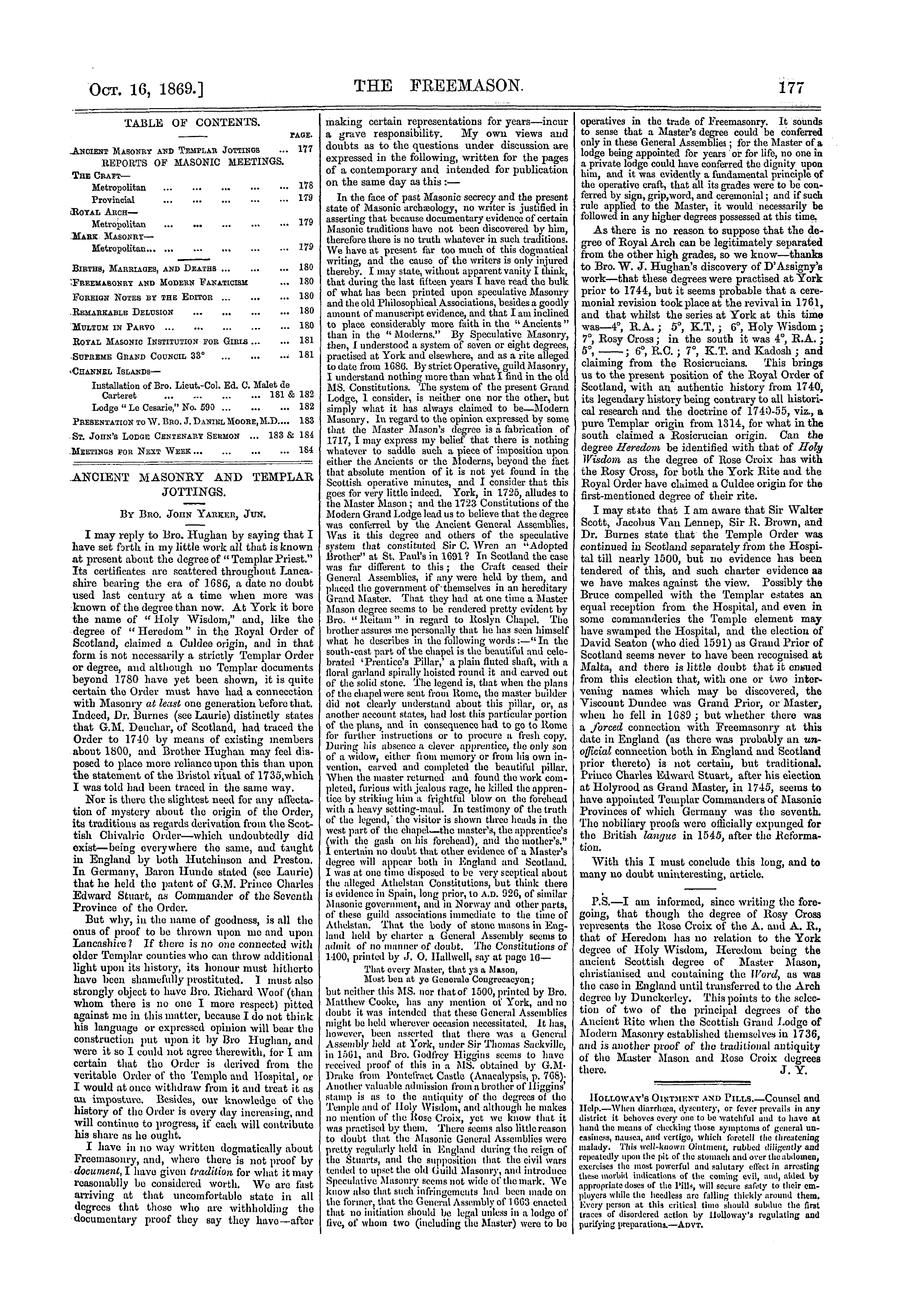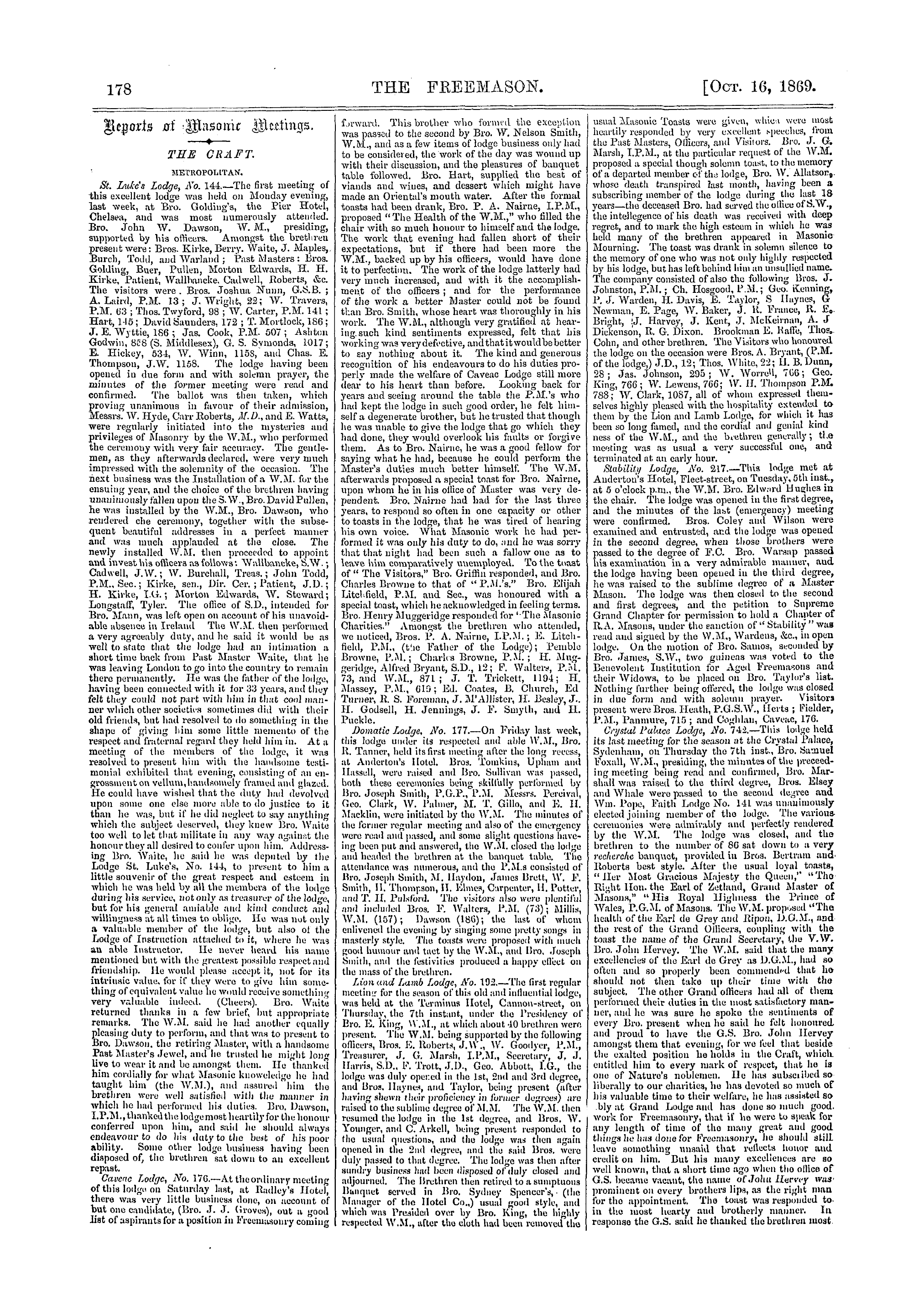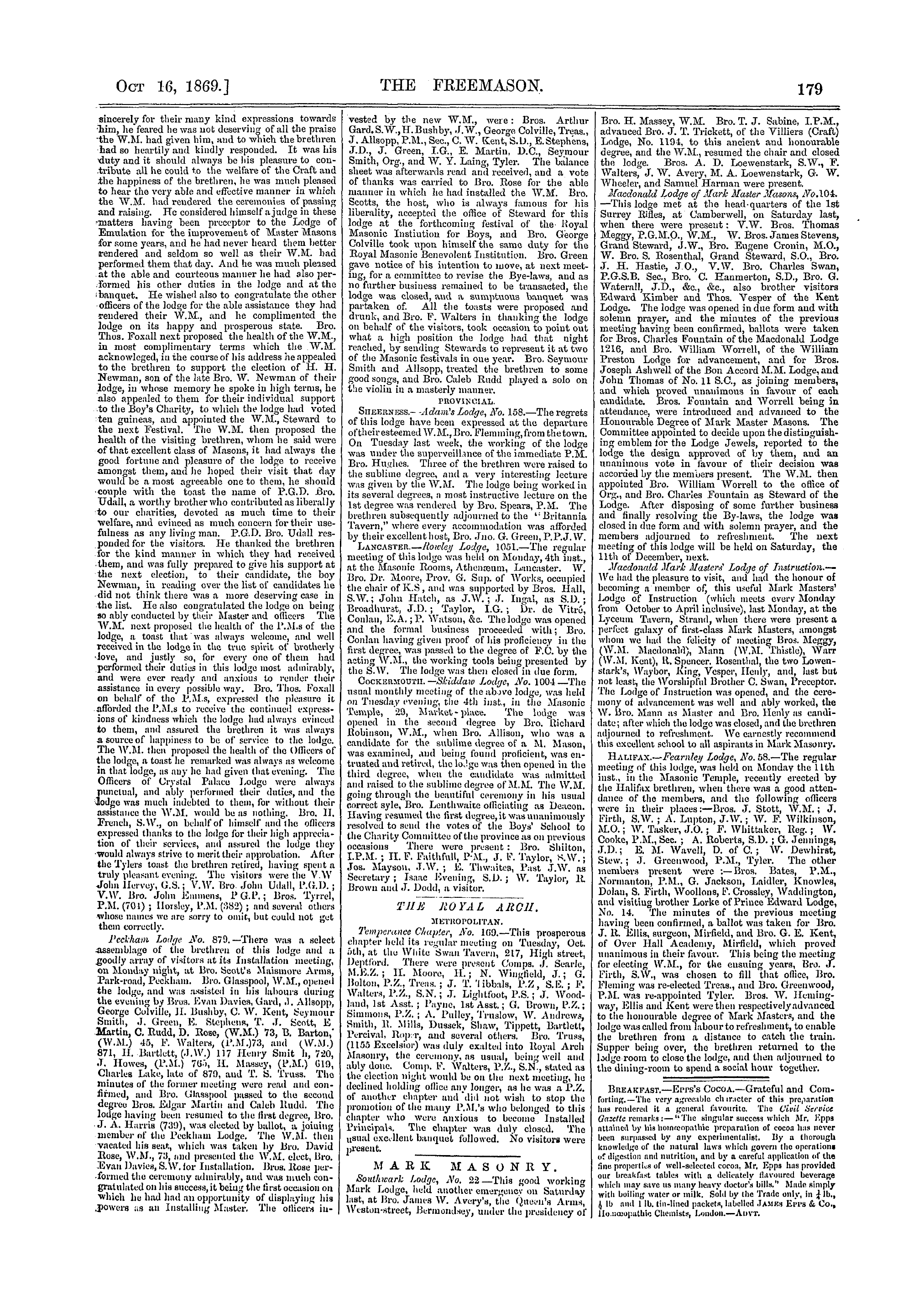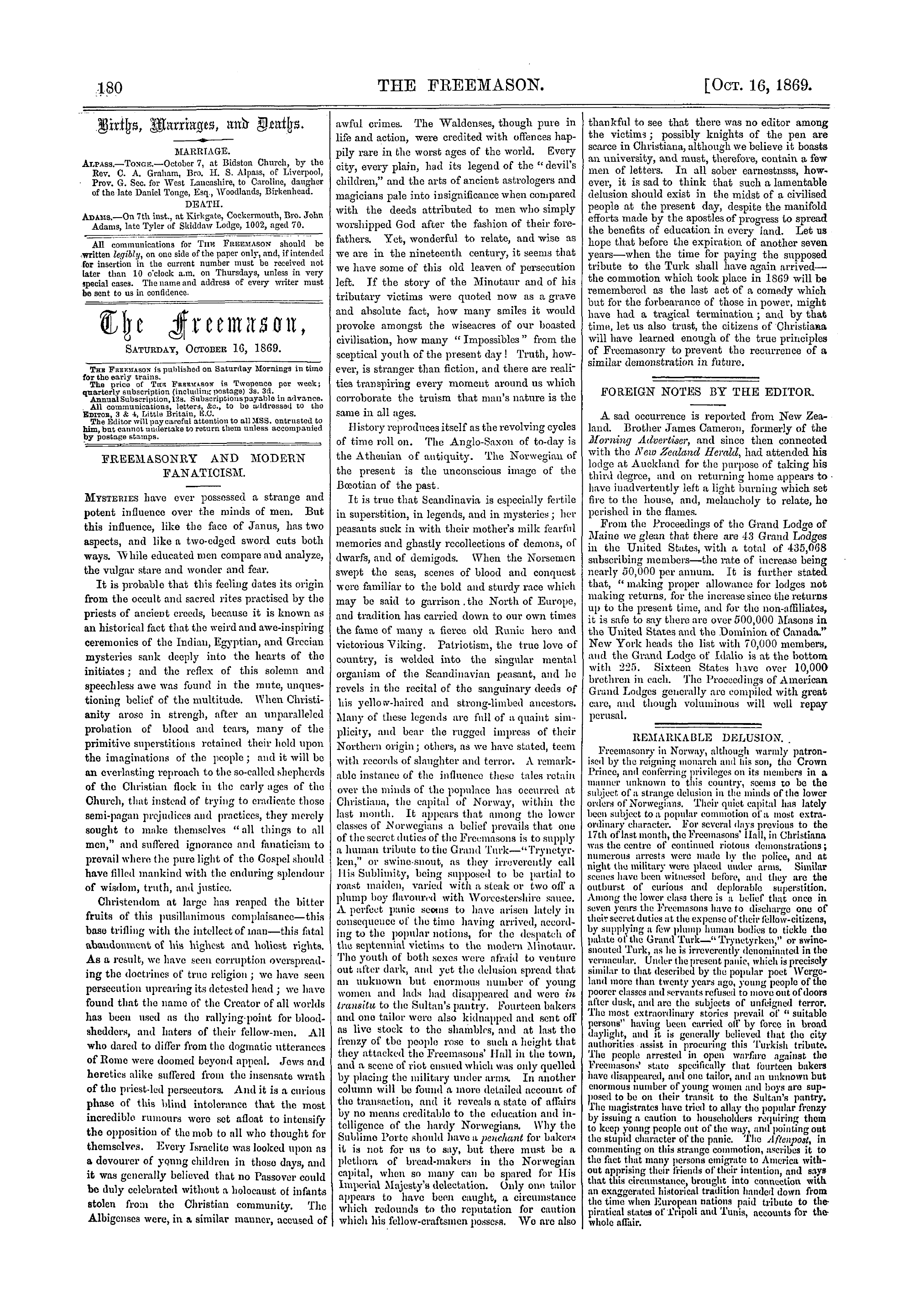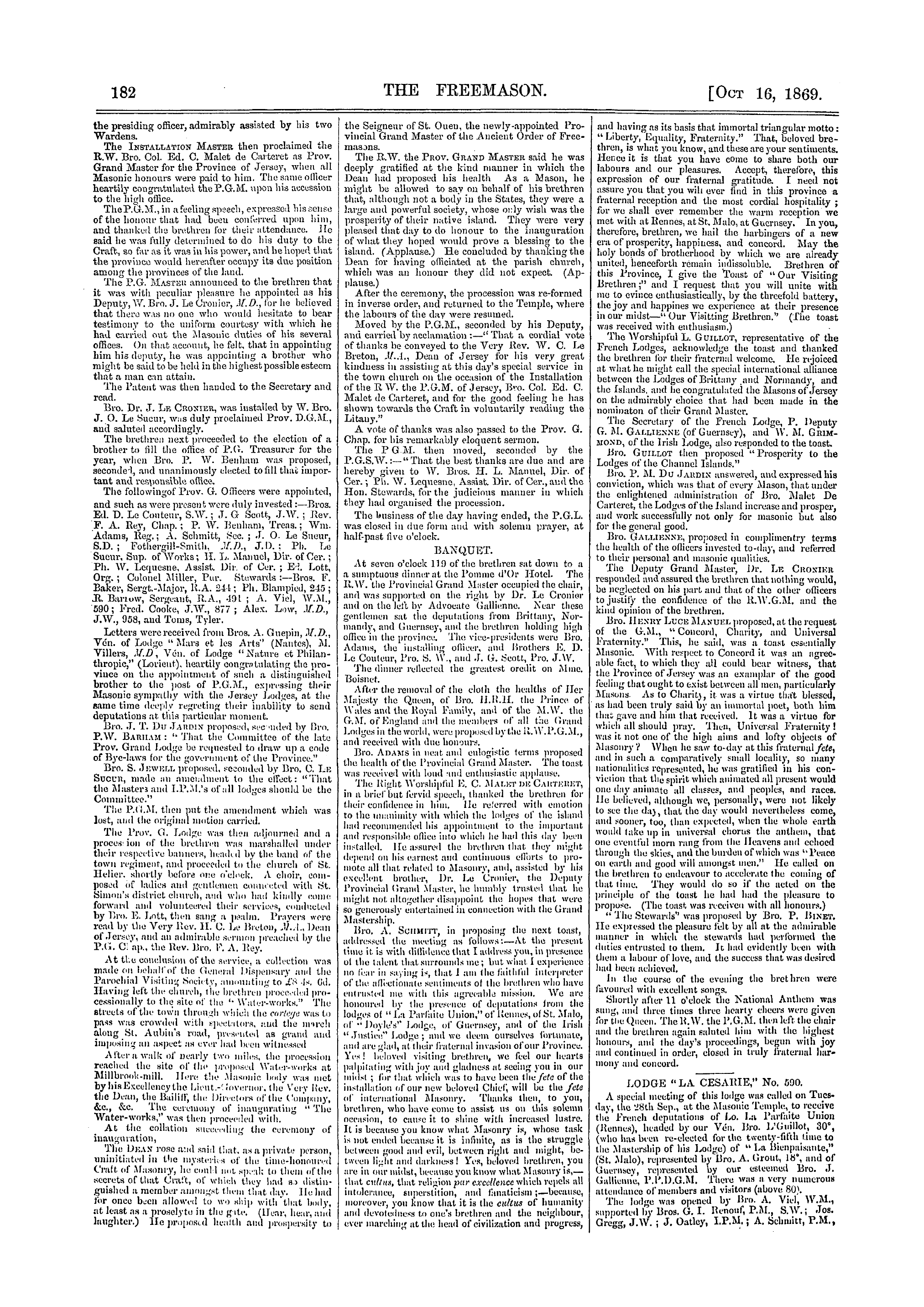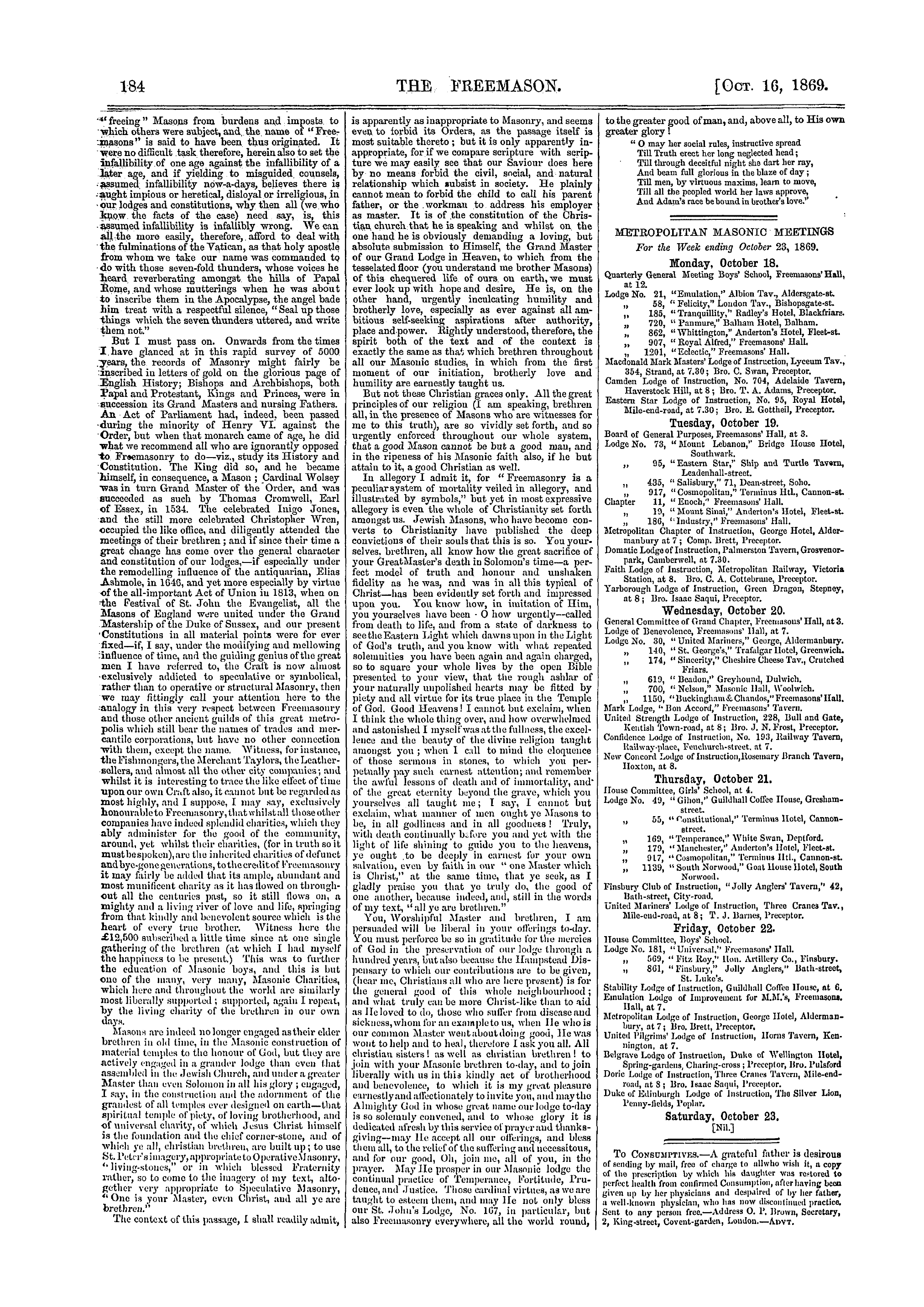-
Articles/Ads
Article TABLE OF CONTENTS. Page 1 of 1 Article ANCIENT MASONRY AND TEMPLAR JOTTINGS. Page 1 of 1 Article ANCIENT MASONRY AND TEMPLAR JOTTINGS. Page 1 of 1 Article ANCIENT MASONRY AND TEMPLAR JOTTINGS. Page 1 of 1
Note: This text has been automatically extracted via Optical Character Recognition (OCR) software.
Table Of Contents.
TABLE OF CONTENTS .
PAGE . . ANCIENT MASONRY AND TEMPLAR . JOTTINGS ... 177 REPORTS OF MASONIC MEETINGS . THE CHAFIMetropolitan 178
Provincial ... 179 tRoYAL ARCHMetropolitan 179 MABK MASONRYMetropolitan ... ... 179
BIRTHS , MARRIAGES , DEATHS 180 ' ¦ FREEMASONRY AND MODERN FANATICISM ... ISO FOREIGN NOTES BY THE EDITOR 180
. REMARKABLE DELUSION 180 MULTOM IN PARVO 180 ROYAL MASONIC INSTITUTION FOR G IRLS 181 SUPREME GRAND COUNCIL 33 ° 181
'C HANNEL ISLANDSInstallation of Bro . Lieut .-Col . Ed . C . Malet de Carteret 181 & 182
Lodge "LeCesarie , " No . S 90 182 PRESENTATION TO \ V . BRO . J . DANIEL MOORE , M . D .... 183 ST . JOHN ' LODGE CENTENARY SERMON ... 183 & 184 MEETINGS FOR NEXT WEEK 184
Ancient Masonry And Templar Jottings.
ANCIENT MASONRY AND TEMPLAR JOTTINGS .
BY BRO . JOHN YARKER , JUN . I may repl y to Bro . Hughan by saying that I have set forth in my little work all thafc is known at present about the degree of " Templar Priest . " Its certificates are scattered throughout
Lancashire bearing the era of 1686 , a date no doubt used last century at a time when more was known of the degree than now . At York it bore the name of " Holy Wisdom , " and , like the degree of " Heredom" in the Royal Order of
Scotland , claimed a Culdee ori gin , and in that form is not necessaril y a strictl y Templar Order or degree , aud although no Templar documents beyond 1780 have yet been shown , it is quite certain tlio Order must have ha . d a connecction
with Masonry at least one generation before that . Indeed , Dr . Burnes ( see Laurie ) distinctly states that G . M . Deuchar , of Scotland , had traced the Order to 1740 by means of existing members
about 1800 , and Brother Hughan may feel disposed to p lace more reliance upon this than upon the statement of the Bristol ritual of 1735 , which I was told had been traced in the same way .
Nor is there the slightest need for any affectation of mystery about the ori gin of the Order , its traditions as regards derivation from the Scottish Chivalric Order—which undoubtedl y did exist—being everywhere the same , aud taught
in England b y both Hutchinson and Preston . In Germany , Baron Hunde stated ( see Laurie ) that he held the patent of G . M . Prince Charles Edward Stuart , as Commander of the Seventh Province of the Order .
But why , iu the name of goodness , is all the onus of proof to be thrown upon me and upon Lancashire ? If there is no ono connected with older Templar counties who can throw additional light upon its history , its honour must hitherto
have been shamefully prostituted . I must also strongly object to have Bro . Richard Woof ( than whom there is no one I moro respect ) p itted against me in this matter , because I do not think his language or expressed opinion will bear the
construction put upon it b y Bro Hughan , and were it so I could not agree therewith , for I am certain that the Order is derived from the veritable Order of the Temple and Hospital , or I would at once withdraw from it and treat ifc as
au imposture . Besides , ouv knowledge of the history of the Order is every day increasing , and will continue to progress , if each will contribute his share as he ought . I have in no way written dogmatically about
Freemasonry , and , where there is not proof by document , I have given tradition for what it may reasonablly be considered worth . We are fast arriving afc that uncomfortable state in all degrees that those who are withholding the documentary proof they say they have—after
Ancient Masonry And Templar Jottings.
making certain representations for years—incur a grave responsibility . M y own views and doubts as to the questions under discussion are expressed in the following , written for the pages of a contemporary and intended for publication on the same day as this : —
In the face of past Masonic secrecy and the present state of "Masonic archaeology , no writer is justified in asserting that because documentary evidence of certain Masonic traditions have not been discovered by him , therefore there is no truth whatever in such traditions . We have at present far too much ot this dogmatical
writing , and the cause of the writers is only injured thereby . I may state , without apparent vanity I think , that during the last fifteen years I have read the bulk of what has been printed upon speculative Masonry and the old Philosophical Associations , besides a goodly amount of manuscript evidence , and that I am inclined
to place considerably more faith in the ' Ancients " than in the " Moderns . " By Speculative Masonry , then , I understood a system of seven or eight degrees , practised at York and elsewhere , and as a rite alleged to date from 1686 . By strict Operative , guild Masonry , I understand nothing more than what I find in the old
MS . Constitutions . The system of the present Grand Lodge , 1 consider , is neither one nor the other , but simply what it has always claimed to be—Modern Masonry . In regard to the opinion expressed by some that the Master Mason ' s degree is a fabrication of 1717 , I may express my belief that there is nothing
whatever to saddle such a piece of imposition upon either the Ancients or the Moderns , beyond the fact that absolute mention of it is not yet found in the Scottish operative minutes , and I consider that this goes for very little indeed . York , in 1725 , alludes to
the Master Mason ; and the 1723 Constitutions of the Modern Grand Lodge lead us to believe that the degree was conferred by the Ancient General Assemblies . Was it this degree and others of the speculative system that constituted Sir C . AVren an "Adopted Brother" at St . Paul ' s in 1691 ? In Scotland the case
was far different to this ; the Craft ceased their General Assemblies , if any were held by them , and placed the government of- themselves in an hereditary Grand Master . That they had at one time a Master Mason degree seems to be rendered pretty evident by Bro . " Reitam" in regard to Roslyn Chapel . The
brother assures me personally that he has seen himself what he describes in the following words : — " In the south-east parfc of the chapel is the beautiful and celebrated 'Prentice ' s Pillar , ' a plain fluted shaft , with a floral garland spirally hoisted round it and carved out of the solid stone . The legend is , that when the plans
of the chapel were sent from Rome , the master builder did not clearly understand about this pillar , or , as another account states , had lost this particular portion of the plans , and in consequence had to go to Rome for further instructions or to procure a fresh copy . During his absence a clever apprentice , the only son
of a widow , either from memory or from his own invention , carved and completed the beautiful pillar . When the master returned and found the work completed , furious with jealous rage , he killed the apprentice by striking him a frightful blow on the forehead with a heavy setting-maul . In testimony of the truth
of the legend , ' the visitor is shown three heads in tho west part of the chapel—the master ' s , the apprentice ' s ( with the gash on his forehead ) , and the mother ' s . " I entertain no doubt that other evidence of a Master ' s degree will appear both in Kngland and Scotland . I was at one time disposed to be very sceptical about the alleged Athelstan Constitutions , but think there
is evidence in Spain , long prior , lo A . D . 92 C , of similar Masonic government , and in Norway and other parts , of these guild associations immediate to the time of Athelstan . That the body of stone masons in England held by charter a General Assembly seems to admit of no manner of doubt . The Constitutions of 1-100 , printed by J . O . Hallwcll , say at page 16—That every Master , that ys a Mason ,
Most ben at ye Generalo Congreeacyon ; but neither this MS . nor that of 1500 , printed b y Bro . Matthew Cooke , has any mention of York , and no doubt it was intended that these General Assemblies might be held wherever occasion necessitated . It has , however , been asserted that there was a General
Assembly held at York , under Sir Thomas Sackville , in 1501 , and Bro . Godfrey Higgins seems to have received proof of this in a MS . obtained by G . MDrake from Pontefhvct Castle ( Anacalypsis , p . 7 G &) - Another valuable admission from a brother of Higgins ' stamp is as to tlie antiquity of the degrees of thc
lemplc and of Holy Wisdom , and although he makes no mention of the Rose Croix , yet we know that it was practised by them . There seems also little reason to doubt that the Masonic General Assemblies were pretty regularly held in England during the reign of
tlie Stuarts , and the supposition that the civil wars tended to upset tlie old Guild Masonry , and introduce Speculative Masonry seems not wide of the mark . We know also that such infringements had been made on the former , that thc General Assembly of 1663 enacted that no initiation should be legal unless in a lodgo ot five , of whom two ( including the Master ) were to be
Ancient Masonry And Templar Jottings.
operatives in the trade of Freemasonry . It sounds to sense that a Master ' s degree could be conferred only in these General Assemblies ; for the Master of a lodge being appointed for years or for life , no one in a private lodge could have conferred the dignity upon him , and it was evidently a fundamental principle of
the operative craft , that all its grades were to be conferred by sign , grip , word , and ceremonial ; and if such rule applied to the Master , it would necessarily be followed in any higher degrees possessed at this time . As there is no reason to suppose that the degree of Royal Arch can be legitimately separated from the other high grades , so we know—thanks
to Bro . W . J . Hughan ' s discovery of D'Assigny ' s work—that these degrees were practised afc York prior to 174-4 , but it seems probable that a ceremonial revision took place at the revival in 1761 , and that whilst the series at York at this time was—4 ° , B , A , ; g K ; . T , 6 ° , Holy Wisdom * 7 ° , Rosy Cross ; in the south it was 4 ° , R . A . ; 5 ° * 6 ° , R . O . : 7 ° , K . T . and Kadosh * and
claiming from the Rosicrucians . This brings us to the present position of the Royal Order of Scotland , with an authentic history from 1740 , its legendary history being contrary to all historical research and the doctrine of 1740-55 , viz ., a
pure Templar ori g in from 1314 , for what in the south claimed a Rosicrucian ori g in . Can the degree Heredom be identified with that of Holy Wisdom as the degree of Rose Croix has with the Rosy Cross , for both the York Rite and the
Royal Order have claimed a Culdee origin for the first-mentioned degree of their rite . I may state that I am aware that Sir Walter Scott , Jacobus Van Lennep , Sir 11 . Brown , and Dr . Burnes state that the Temple Order was
continued in Scotland separatel y from the Hospital till nearly 1500 , but no evidence has been tendered of this , and such charter evidence as we have makes against the view . Possibly the Bruce compelled with the Templar estates an
equal recejition from the Hospital , and even in some commanderies the Temple element may have swamped the Hospital , and the election of David Seaton ( who died 1591 ) as Grand Prior of Scotland seems never to have been recognised at
Malta , and there is little doubt that ifc endued from this election that , with one or two intervening names which may be discovered , the Viscount Dundee was Grand Prior , or Master , when he fell in 1 GS 9 : but whether there waa
a forced connection with Freemasonry at this date in England ( as there was probably an unofficial connection both in England and Scotland prior thereto ) is not certain , but traditional . Prince Charles Edward Stuart , after his election
at Holyrood as Grand Master , in 1745 , seems to have appointed Templar Commanders of Masonic Provinces of which Germany was the seventh . The nobiliary proofs were officiall y expunged for the British langue in 1545 , after the Reformation .
With this I must conclude this long , and to many no doubt uninteresting , article . P . S . —I am informed , since writing the foregoing , that though the degree of Rosy Cross represents the Rose Croix of the A . and A . R .,
that of Heredom has no relation to tlie York degree of Holy Wisdom , Heredom being the ancient Scottish degree of Master Mason , christianised and containing the Word , as was the case in England until transferred to the Arch
degree by Dunckerley . This points to the selection of two of the principal degrees of the Ancient Rite when the Scottish Grand Lodge of
Modern Masonry established themselves in 1736 , and is another proof of tho traditional antiquity of the Master Mason and Rose Croix degrees there . J . Y .
HOLLOWAV ' S OINTMENT AND PILLS Counsel and Help . —When diarrhoea , dysentery , or fever prevails in any district it behoves every one to be watchful and to havo at hand the means of checking those symptoms of general uneasiness , nausea , and vertigo , which foretell the threatening malady . This well-known Ointment , rubbed diligently and repeatedly upon the pit of thc stomach and over tlie abdomen ,
exercises the most powerful and salutary effect in arresting these morbid indications of the coming evil , and , aided by appropriate doses of the Pills , will secure safety to their employers while the heedless are falling thickly around them . Kvery person at this critical timo should subdue the first traces of disordered action by llollowuy ' s regulating and purifying preparations . — ADVT .
Note: This text has been automatically extracted via Optical Character Recognition (OCR) software.
Table Of Contents.
TABLE OF CONTENTS .
PAGE . . ANCIENT MASONRY AND TEMPLAR . JOTTINGS ... 177 REPORTS OF MASONIC MEETINGS . THE CHAFIMetropolitan 178
Provincial ... 179 tRoYAL ARCHMetropolitan 179 MABK MASONRYMetropolitan ... ... 179
BIRTHS , MARRIAGES , DEATHS 180 ' ¦ FREEMASONRY AND MODERN FANATICISM ... ISO FOREIGN NOTES BY THE EDITOR 180
. REMARKABLE DELUSION 180 MULTOM IN PARVO 180 ROYAL MASONIC INSTITUTION FOR G IRLS 181 SUPREME GRAND COUNCIL 33 ° 181
'C HANNEL ISLANDSInstallation of Bro . Lieut .-Col . Ed . C . Malet de Carteret 181 & 182
Lodge "LeCesarie , " No . S 90 182 PRESENTATION TO \ V . BRO . J . DANIEL MOORE , M . D .... 183 ST . JOHN ' LODGE CENTENARY SERMON ... 183 & 184 MEETINGS FOR NEXT WEEK 184
Ancient Masonry And Templar Jottings.
ANCIENT MASONRY AND TEMPLAR JOTTINGS .
BY BRO . JOHN YARKER , JUN . I may repl y to Bro . Hughan by saying that I have set forth in my little work all thafc is known at present about the degree of " Templar Priest . " Its certificates are scattered throughout
Lancashire bearing the era of 1686 , a date no doubt used last century at a time when more was known of the degree than now . At York it bore the name of " Holy Wisdom , " and , like the degree of " Heredom" in the Royal Order of
Scotland , claimed a Culdee ori gin , and in that form is not necessaril y a strictl y Templar Order or degree , aud although no Templar documents beyond 1780 have yet been shown , it is quite certain tlio Order must have ha . d a connecction
with Masonry at least one generation before that . Indeed , Dr . Burnes ( see Laurie ) distinctly states that G . M . Deuchar , of Scotland , had traced the Order to 1740 by means of existing members
about 1800 , and Brother Hughan may feel disposed to p lace more reliance upon this than upon the statement of the Bristol ritual of 1735 , which I was told had been traced in the same way .
Nor is there the slightest need for any affectation of mystery about the ori gin of the Order , its traditions as regards derivation from the Scottish Chivalric Order—which undoubtedl y did exist—being everywhere the same , aud taught
in England b y both Hutchinson and Preston . In Germany , Baron Hunde stated ( see Laurie ) that he held the patent of G . M . Prince Charles Edward Stuart , as Commander of the Seventh Province of the Order .
But why , iu the name of goodness , is all the onus of proof to be thrown upon me and upon Lancashire ? If there is no ono connected with older Templar counties who can throw additional light upon its history , its honour must hitherto
have been shamefully prostituted . I must also strongly object to have Bro . Richard Woof ( than whom there is no one I moro respect ) p itted against me in this matter , because I do not think his language or expressed opinion will bear the
construction put upon it b y Bro Hughan , and were it so I could not agree therewith , for I am certain that the Order is derived from the veritable Order of the Temple and Hospital , or I would at once withdraw from it and treat ifc as
au imposture . Besides , ouv knowledge of the history of the Order is every day increasing , and will continue to progress , if each will contribute his share as he ought . I have in no way written dogmatically about
Freemasonry , and , where there is not proof by document , I have given tradition for what it may reasonablly be considered worth . We are fast arriving afc that uncomfortable state in all degrees that those who are withholding the documentary proof they say they have—after
Ancient Masonry And Templar Jottings.
making certain representations for years—incur a grave responsibility . M y own views and doubts as to the questions under discussion are expressed in the following , written for the pages of a contemporary and intended for publication on the same day as this : —
In the face of past Masonic secrecy and the present state of "Masonic archaeology , no writer is justified in asserting that because documentary evidence of certain Masonic traditions have not been discovered by him , therefore there is no truth whatever in such traditions . We have at present far too much ot this dogmatical
writing , and the cause of the writers is only injured thereby . I may state , without apparent vanity I think , that during the last fifteen years I have read the bulk of what has been printed upon speculative Masonry and the old Philosophical Associations , besides a goodly amount of manuscript evidence , and that I am inclined
to place considerably more faith in the ' Ancients " than in the " Moderns . " By Speculative Masonry , then , I understood a system of seven or eight degrees , practised at York and elsewhere , and as a rite alleged to date from 1686 . By strict Operative , guild Masonry , I understand nothing more than what I find in the old
MS . Constitutions . The system of the present Grand Lodge , 1 consider , is neither one nor the other , but simply what it has always claimed to be—Modern Masonry . In regard to the opinion expressed by some that the Master Mason ' s degree is a fabrication of 1717 , I may express my belief that there is nothing
whatever to saddle such a piece of imposition upon either the Ancients or the Moderns , beyond the fact that absolute mention of it is not yet found in the Scottish operative minutes , and I consider that this goes for very little indeed . York , in 1725 , alludes to
the Master Mason ; and the 1723 Constitutions of the Modern Grand Lodge lead us to believe that the degree was conferred by the Ancient General Assemblies . Was it this degree and others of the speculative system that constituted Sir C . AVren an "Adopted Brother" at St . Paul ' s in 1691 ? In Scotland the case
was far different to this ; the Craft ceased their General Assemblies , if any were held by them , and placed the government of- themselves in an hereditary Grand Master . That they had at one time a Master Mason degree seems to be rendered pretty evident by Bro . " Reitam" in regard to Roslyn Chapel . The
brother assures me personally that he has seen himself what he describes in the following words : — " In the south-east parfc of the chapel is the beautiful and celebrated 'Prentice ' s Pillar , ' a plain fluted shaft , with a floral garland spirally hoisted round it and carved out of the solid stone . The legend is , that when the plans
of the chapel were sent from Rome , the master builder did not clearly understand about this pillar , or , as another account states , had lost this particular portion of the plans , and in consequence had to go to Rome for further instructions or to procure a fresh copy . During his absence a clever apprentice , the only son
of a widow , either from memory or from his own invention , carved and completed the beautiful pillar . When the master returned and found the work completed , furious with jealous rage , he killed the apprentice by striking him a frightful blow on the forehead with a heavy setting-maul . In testimony of the truth
of the legend , ' the visitor is shown three heads in tho west part of the chapel—the master ' s , the apprentice ' s ( with the gash on his forehead ) , and the mother ' s . " I entertain no doubt that other evidence of a Master ' s degree will appear both in Kngland and Scotland . I was at one time disposed to be very sceptical about the alleged Athelstan Constitutions , but think there
is evidence in Spain , long prior , lo A . D . 92 C , of similar Masonic government , and in Norway and other parts , of these guild associations immediate to the time of Athelstan . That the body of stone masons in England held by charter a General Assembly seems to admit of no manner of doubt . The Constitutions of 1-100 , printed by J . O . Hallwcll , say at page 16—That every Master , that ys a Mason ,
Most ben at ye Generalo Congreeacyon ; but neither this MS . nor that of 1500 , printed b y Bro . Matthew Cooke , has any mention of York , and no doubt it was intended that these General Assemblies might be held wherever occasion necessitated . It has , however , been asserted that there was a General
Assembly held at York , under Sir Thomas Sackville , in 1501 , and Bro . Godfrey Higgins seems to have received proof of this in a MS . obtained by G . MDrake from Pontefhvct Castle ( Anacalypsis , p . 7 G &) - Another valuable admission from a brother of Higgins ' stamp is as to tlie antiquity of the degrees of thc
lemplc and of Holy Wisdom , and although he makes no mention of the Rose Croix , yet we know that it was practised by them . There seems also little reason to doubt that the Masonic General Assemblies were pretty regularly held in England during the reign of
tlie Stuarts , and the supposition that the civil wars tended to upset tlie old Guild Masonry , and introduce Speculative Masonry seems not wide of the mark . We know also that such infringements had been made on the former , that thc General Assembly of 1663 enacted that no initiation should be legal unless in a lodgo ot five , of whom two ( including the Master ) were to be
Ancient Masonry And Templar Jottings.
operatives in the trade of Freemasonry . It sounds to sense that a Master ' s degree could be conferred only in these General Assemblies ; for the Master of a lodge being appointed for years or for life , no one in a private lodge could have conferred the dignity upon him , and it was evidently a fundamental principle of
the operative craft , that all its grades were to be conferred by sign , grip , word , and ceremonial ; and if such rule applied to the Master , it would necessarily be followed in any higher degrees possessed at this time . As there is no reason to suppose that the degree of Royal Arch can be legitimately separated from the other high grades , so we know—thanks
to Bro . W . J . Hughan ' s discovery of D'Assigny ' s work—that these degrees were practised afc York prior to 174-4 , but it seems probable that a ceremonial revision took place at the revival in 1761 , and that whilst the series at York at this time was—4 ° , B , A , ; g K ; . T , 6 ° , Holy Wisdom * 7 ° , Rosy Cross ; in the south it was 4 ° , R . A . ; 5 ° * 6 ° , R . O . : 7 ° , K . T . and Kadosh * and
claiming from the Rosicrucians . This brings us to the present position of the Royal Order of Scotland , with an authentic history from 1740 , its legendary history being contrary to all historical research and the doctrine of 1740-55 , viz ., a
pure Templar ori g in from 1314 , for what in the south claimed a Rosicrucian ori g in . Can the degree Heredom be identified with that of Holy Wisdom as the degree of Rose Croix has with the Rosy Cross , for both the York Rite and the
Royal Order have claimed a Culdee origin for the first-mentioned degree of their rite . I may state that I am aware that Sir Walter Scott , Jacobus Van Lennep , Sir 11 . Brown , and Dr . Burnes state that the Temple Order was
continued in Scotland separatel y from the Hospital till nearly 1500 , but no evidence has been tendered of this , and such charter evidence as we have makes against the view . Possibly the Bruce compelled with the Templar estates an
equal recejition from the Hospital , and even in some commanderies the Temple element may have swamped the Hospital , and the election of David Seaton ( who died 1591 ) as Grand Prior of Scotland seems never to have been recognised at
Malta , and there is little doubt that ifc endued from this election that , with one or two intervening names which may be discovered , the Viscount Dundee was Grand Prior , or Master , when he fell in 1 GS 9 : but whether there waa
a forced connection with Freemasonry at this date in England ( as there was probably an unofficial connection both in England and Scotland prior thereto ) is not certain , but traditional . Prince Charles Edward Stuart , after his election
at Holyrood as Grand Master , in 1745 , seems to have appointed Templar Commanders of Masonic Provinces of which Germany was the seventh . The nobiliary proofs were officiall y expunged for the British langue in 1545 , after the Reformation .
With this I must conclude this long , and to many no doubt uninteresting , article . P . S . —I am informed , since writing the foregoing , that though the degree of Rosy Cross represents the Rose Croix of the A . and A . R .,
that of Heredom has no relation to tlie York degree of Holy Wisdom , Heredom being the ancient Scottish degree of Master Mason , christianised and containing the Word , as was the case in England until transferred to the Arch
degree by Dunckerley . This points to the selection of two of the principal degrees of the Ancient Rite when the Scottish Grand Lodge of
Modern Masonry established themselves in 1736 , and is another proof of tho traditional antiquity of the Master Mason and Rose Croix degrees there . J . Y .
HOLLOWAV ' S OINTMENT AND PILLS Counsel and Help . —When diarrhoea , dysentery , or fever prevails in any district it behoves every one to be watchful and to havo at hand the means of checking those symptoms of general uneasiness , nausea , and vertigo , which foretell the threatening malady . This well-known Ointment , rubbed diligently and repeatedly upon the pit of thc stomach and over tlie abdomen ,
exercises the most powerful and salutary effect in arresting these morbid indications of the coming evil , and , aided by appropriate doses of the Pills , will secure safety to their employers while the heedless are falling thickly around them . Kvery person at this critical timo should subdue the first traces of disordered action by llollowuy ' s regulating and purifying preparations . — ADVT .
